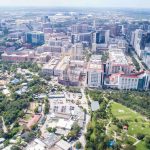September 05, 2017 – Digitized Medicine | Physician Perspectives on Health IT
I am more than 400 miles from the Texas Gulf Coast, and I am a different person today.
I rarely write about my professional experiences as a pediatric emergency physician in Digitized Medicine. After all, this blog “belongs” to my other passion which is to promote the maturation and use of health IT to improve the quality of healthcare. But I had an extraordinary experience in the emergency room yesterday that connected the dots between personal face-to-face care and use of health IT to improve care. It was extraordinary in how it led me on a personal journey to seek a better understanding, or perhaps acceptance, of human suffering under God’s benevolent watch.
In the ER I cared for a young boy whose family from Port Arthur, Texas, currently “resides” in a Fort Worth public shelter as a Hurricane Harvey flood victim. In order to get medical record information on this displaced patient, I called the Greater Houston HealthConnect (GHH) which is a regional health information exchange (HIE) that remotely stores electronic health information for over 4 million patients from the Houston/Beaumont region in southeast Texas. For patients in the Corpus Christi area the HASA HIE similarly stores patient information. The HIE help desk representative took my name/phone number and told me I would receive a call-back in a few minutes from an HIE representative who was physically working at a Houston flood shelter. Less than 5 minutes later I received that call. It was as noisy in her background as it was in my ER. The HIE rep asked me for the patient’s demographic information, then found him in their database within one minute. There was information from several hospital visits recorded that we together browsed through for a couple of minutes. She would describe the types of online information available while I provided direction on what to skip and what to drill down into. Although available data on this patient was sparse, our findings gave evidence to my initial diagnostic impression and reduced the risk of chasing unlikely etiologies of the patient’s condition. Considering the circumstances, I found the experience efficient and valuable.
So if you are a physician seeing a displaced Hurricane Harvey victim, you may find HIE services useful for accessing additional medical record information:
-
For patients from the Houston/Beaumont/Port Arthur region, call 832-564-2599 (GHH)
-
For patients from the Corpus Christi area, call 210-918-1361 (HASA)
-
More information is available on the Texas Medical Association website
Those are the facts of the story along with some practical advice. But on a personal level I am a different person today.
Before entering the room I reviewed nursing notes which informed me that this young boy and his mother had been sent from Fort Worth’s emergency shelter. I took a moment to mentally prepare myself and entered the room. Since nature had physically displaced this mother from her home, family and friends, I felt sure I would see and feel the emotional strain that such isolation must yield. Despite this preparation my heart pierced and spine shivered as soon as I looked into mother’s eyes. They were deep and disturbingly languid. But I was honestly not prepared for a different feeling–one that was difficult and seemed to come from within my own being–that slugged me in the gut as we sat face-to-face. I did not understand in that moment exactly what I was feeling. I had a job to do and just got busy serving this family to the best of my ability.
I understand through training and experience that physicians should remain aware of the potential transference of emotions from patient to physician. So after my ER shift I took some time at home to quietly discern what it was that struck me so harshly. I recognized that I had indeed felt the transference of emotional fear from homelessness and loneliness due to isolation. But I gradually came to realize the most disturbing emotion–the one that sucker-punched me–actually originated from within myself. It was my own personal thoughts and feelings about this mother’s worldly disempowerment that pierced my heart and shook my spine as we sat and spoke.
However, while in the room I also sensed something else in the fabric of this young mother’s framework that served as a basis of survival, even if just by a thread. Afterall, she had made it to an unfamiliar hospital with her ill son from a flooded home more than 430 miles away. I was sure she must have some physical and mental attributes that served as sources of some strength, but I felt something much deeper. As I later reflected on this, I came to firmly believe that this young mother’s core framework of strength must be built around her spiritual marrow. A marrow encased in bone that nature cannot break. A marrow with everlasting spiritual empowerment. A marrow undisturbed, and even strengthened, by worldly strife. With these thoughts in mind I turned to the book of Psalms. I found a chapter that spoke to me about the spiritual marrow of righteous people who nevertheless are afflicted with suffering:
The LORD is close to the brokenhearted, saves those whose spirit is crushed. Many are the troubles of the righteous, but the LORD delivers him from them all. He watches over all his bones; not one of them shall be broken.
I give praise to God’s gift of spiritual marrow. I pray for all victims of natural disaster. Love and blessings to each of them.







